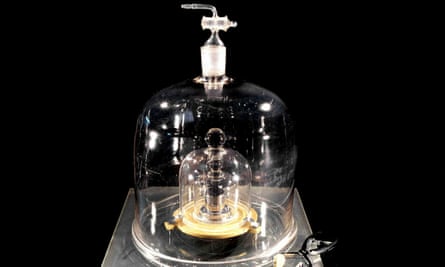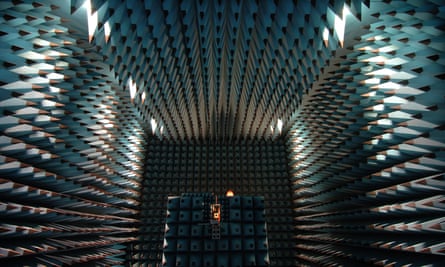For the band of specialists in the much-overlooked arena of metrology, it will be the most profound moment in more than a century. Since 1889, one of the pillars of the science, the kilogram, has been defined by a lump of metal held in a triple-locked vault in a lab on the outskirts of Paris. It is the one true kilogram in the world.
But not for much longer. Next week, leading figures in the field are set to make history. At the general conference on weights and measures in Versailles, representatives from 57 nations will vote for change. And so the kilogram, the only metric unit still based on a solitary object, will be reborn. Henceforth, the kilogram will be derived from a fundamental constant, a number that is woven into the fabric of the universe.
The vote is essentially a done deal. The debates have been had, the solutions agreed. But even popular revolutions can be tense affairs. “It will be nerve-racking,” said Stephan Schlamminger, a physicist at the US National Institute of Standards and Technology, who will be in Versailles for the vote. “I’ve been thinking about this, or working on it, for as long as I have been a scientist. Sometimes I am in a state of disbelief. Is this really going to happen? Will I wake up and find this is all a dream?”

Much of the week’s meeting will be devoted to routine affairs such as budgets and the like, with votes cast on the Friday. “It will be nice to know that the whole thing has been resolved,” said Stuart Davidson, the head of mass metrology at the national physical laboratory in Teddington. “We’ll know, at least, that no-one has stood up and said this is rubbish, we’re not going with it.”
The roots of modern measurement can be traced back to the mid-18th century, when it became clear that nations might do well to share common units. With international trade on the up, it made no sense to price rolls of fabric, for example, according to the local duke’s shoe size. In the late 1700s King Louis XVI commissioned scientists to find a more sensible approach.
The assembled group proposed a system inspired by the natural world, one intended “for all times, for all people”. A metre was defined as one ten-millionth of the distance from the North Pole to the equator. A kilogram was the mass of a litre of water. To make the units more practical, each was enshrined in a physical object, a metal bar for the metre, and a weight for the kilogram. In time, the scheme evolved into an international system of units (SI) with seven base units: the metre for distance, the second for time, the kilogram for mass, the mole for amount of substance, the ampere for electrical current, the kelvin for temperature, and the candela for luminosity.
For the past 129 years, the world’s official unit of mass has been the international prototype kilogram, or IPK, a shiny cylinder of platinum-iridium stored under three sealed bell jars at the international bureau of weights and measures (BIPM) in Sèvres, west of Paris. National metrology labs hold copies of the IPK to calibrate measurements in their own countries. Every 40 years or so, the copies are returned to Paris for checks against the IPK, nicknamed Le Grand K.
It’s not a bad system. Because Le Grand K defines the kilogram, its mass is never in doubt. It is always, with 100% accuracy, one kilogram. And yet its weight goes up and down. In storage, the platinum picks up pollutants from the air and the cylinder gets ever so slightly heavier. When it is cleaned, the kilogram loses weight as tiny amounts of alloy are removed. The net effect is hard to gauge, but copies can put on tens of micrograms in a century. All scientists know for sure is that the kilogram that defines all others is not what it used to be.

It is enough to irk metrologists. “If aliens ever visit Earth what else would we talk about other than physics?” said Schlamminger. “If we want to talk about physics we have to agree on a set of units, but if we say our unit of mass is based on a lump of metal we keep in Paris, we’ll be the laughing stock of the universe.”
If the vote proceeds as expected, Earth will be spared such galactic shame. Since 1983, the metre has been derived from the speed of light in a vacuum. The kilogram makeover will derive mass from the Planck constant, a number deeply rooted in the quantum world. It describes the size of bundles of energy, known as quanta, which pour out of a hot oven, for example.
The redefinition is easier said than done. Scientists first use a supremely sensitive piece of equipment called a Kibble balance to calculate Planck’s constant from a 1kg reference mass. The instrument is similar to a scales, but instead of counteracting one weight with another, the object being weighed is balanced by electromagnetic forces. Planck’s constant is proportional to the energy needed to balance the mass. Then, armed with a precise value for Planck’s constant, researchers can do the reverse, and use the balance to measure unknown masses.
With a positive vote the new system of units, including updates to the mole, Kelvin and ampere, comes into effect on 20 May 2019. The revolution will hardly be felt beyond the world of metrology. No one will weigh their carrots any differently at the supermarket. But behind the scenes, a more elegant system will be at work.
“The greatest satisfaction for me will be completing the historic arc that started with the French revolution,” said Schlamminger. “The idea was to have a measurement system for all times and for all people. They fell short on the kilogram. It has these problems with stability, so it is not for all times, and it is locked in a safe, so it is not for all people. Planck’s constant never changes, so it is the same for all time. And its value is woven into the fabric of the universe, so it is there for everyone.”
